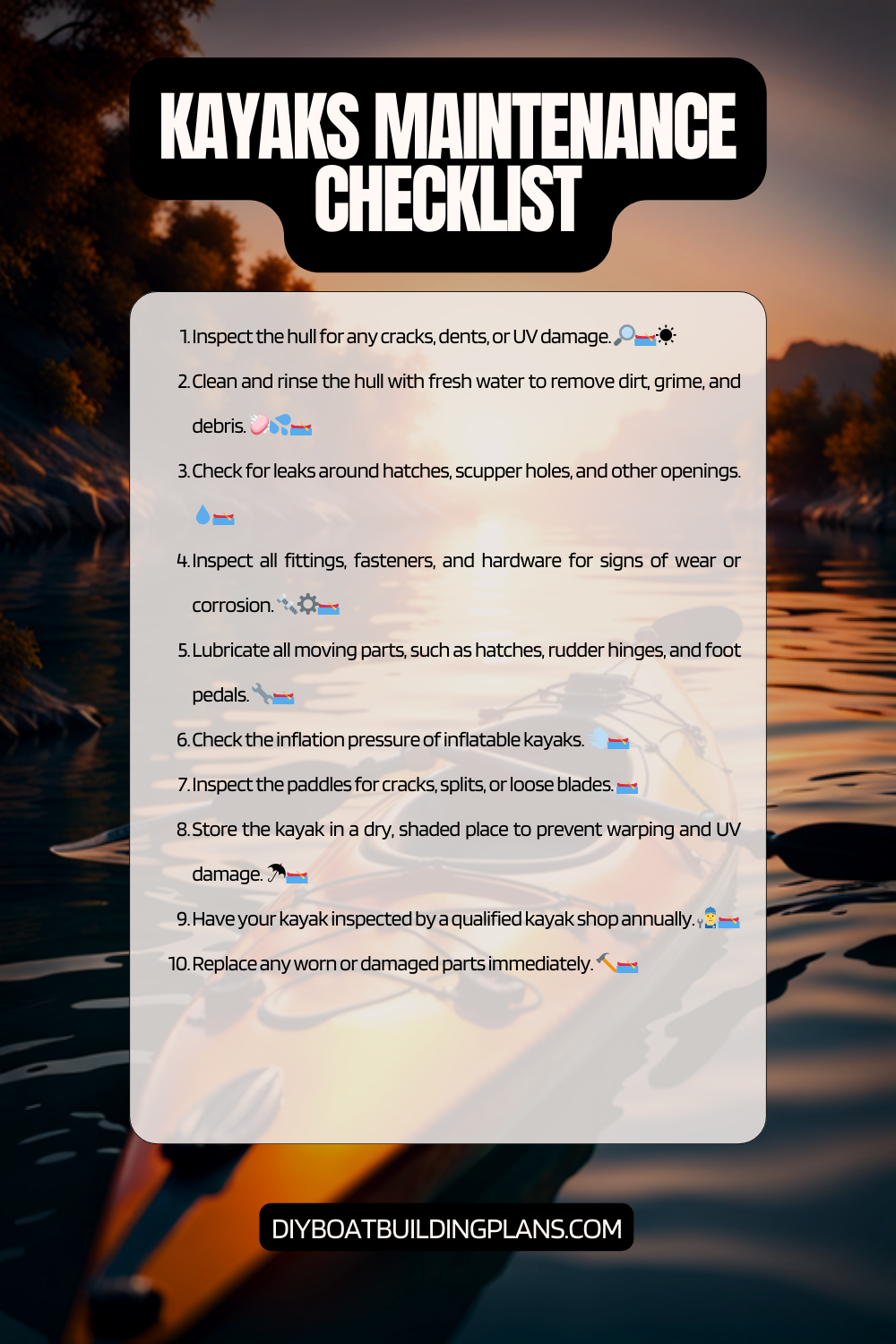Overview of Kayak Maintenance Tips
Kayaking is a popular outdoor activity that allows individuals to explore the beauty of nature while enjoying a thrilling adventure on the water. However, many kayakers often overlook the importance of regular kayak maintenance. Proper maintenance not only ensures the longevity of your kayak but also enhances your overall kayaking experience.
Regular kayak maintenance offers numerous benefits. Firstly, it helps to prevent any potential damage or wear and tear that may occur over time. By taking care of your kayak, you can avoid costly repairs or replacements in the future. Secondly, maintaining your kayak ensures that it remains in optimal condition, allowing for better performance on the water. Lastly, proper maintenance contributes to the safety of your kayaking trips, as a well-maintained kayak is less likely to encounter unexpected issues while out on the water.
Key Takeaways
- Regular cleaning and proper storage are essential for maintaining your kayak’s longevity.
- Protect your kayak from sun damage by storing it in a shaded area or using a UV-resistant cover.
- Lubricate moving parts, such as hinges and rudders, to prevent rust and corrosion.
- Check and replace hardware, such as screws and bolts, to ensure your kayak is safe to use.
- Properly winterize your kayak by draining all water and storing it in a dry, cool place.

Cleaning Your Kayak: Tips and Tricks
Cleaning your kayak is an essential part of its maintenance routine. To effectively clean your kayak, you will need a few materials such as mild soap or detergent, a soft sponge or cloth, a hose or bucket of water, and a scrub brush for stubborn stains.
To begin cleaning your kayak, rinse it with fresh water to remove any loose debris or dirt. Then, mix mild soap or detergent with water and use a soft sponge or cloth to gently scrub the surface of your kayak. Pay attention to areas that are prone to dirt buildup, such as the cockpit and storage compartments. Rinse off the soap thoroughly with fresh water and allow your kayak to air dry.
Stubborn stains can be challenging to remove, but there are a few tricks you can try. For scuff marks or adhesive residue, rubbing alcohol or white vinegar can be effective in breaking down the stain. Apply a small amount onto a cloth and gently rub the affected area until the stain disappears. For more persistent stains, baking soda mixed with water into a paste-like consistency can be used as a natural abrasive. Apply the paste onto the stain, let it sit for a few minutes, and then scrub it off with a brush.
How to Store Your Kayak Properly
Proper storage is crucial for maintaining the integrity of your kayak. When choosing a storage location, it is important to consider factors such as protection from the elements, accessibility, and available space. There are different types of kayak storage options to choose from, depending on your needs and available space.
If you have enough space indoors, storing your kayak in a garage or shed is ideal. Make sure to keep it away from direct sunlight and extreme temperature changes. If indoor storage is not an option, outdoor storage can still be suitable with proper precautions. Invest in a kayak cover or tarp to protect your kayak from rain, snow, and UV rays. Additionally, consider elevating your kayak off the ground using a rack or suspension system to prevent damage from moisture or pests.
When storing your kayak outdoors, it is important to periodically check for any signs of damage or wear. Inspect the hull for cracks or dents and ensure that the storage area is secure and stable. Regularly clean your kayak before storing it to prevent any dirt or debris from causing damage over time.
Protecting Your Kayak from Sun Damage
| Factors | Importance | Actions |
| Sunscreen | High | Apply a UV-resistant spray or wax to the kayak surface |
| Storage | High | Store the kayak in a shaded area or cover it with a tarp |
| Material | Medium | Choose a kayak made of UV-resistant material |
| Cleaning | Low | Clean the kayak regularly to remove dirt and debris that can trap heat and cause damage |
Sun damage can be detrimental to the longevity of your kayak. Prolonged exposure to UV rays can cause fading, cracking, and weakening of the materials used in the construction of your kayak. To protect your kayak from sun damage, there are a few tips you can follow.
Firstly, whenever possible, store your kayak in a shaded area or use a kayak cover that provides UV protection. This will shield your kayak from direct sunlight and minimize the risk of sun damage. If storing indoors is not an option, consider using a reflective tarp or cover that reflects sunlight away from your kayak.
Secondly, applying a UV protectant spray or wax to your kayak can help to mitigate the effects of sun damage. These products create a protective barrier that shields the kayak’s surface from harmful UV rays. Be sure to choose a product specifically designed for kayaks and follow the manufacturer’s instructions for application.
Lastly, when not in use, try to keep your kayak out of direct sunlight. If you are taking a break during your kayaking trip, find a shaded area to rest your kayak. This will help to prevent unnecessary exposure to the sun and prolong the lifespan of your kayak.
Maintaining the Kayak’s Hull and Deck
The hull and deck of your kayak are crucial components that require regular maintenance to ensure optimal performance and longevity. The hull is the bottom part of the kayak that comes into contact with the water, while the deck is the top part where you sit or store your gear.
Maintaining the hull and deck starts with regular cleaning. As mentioned earlier, use mild soap or detergent and a soft sponge or cloth to clean these areas. Pay attention to any dirt or debris that may accumulate in crevices or storage compartments. Regular cleaning not only keeps your kayak looking its best but also prevents any buildup that could potentially affect its performance.
In addition to cleaning, it is important to inspect the hull and deck for any signs of damage. Look for cracks, dents, or deep scratches that could compromise the integrity of your kayak. If you notice any damage, it is crucial to address it promptly to prevent further issues.
To maintain the hull and deck, consider using specific products designed for kayak maintenance. There are various cleaners and protectants available on the market that can help to remove stains, restore shine, and provide additional protection against UV rays and other environmental factors. Follow the manufacturer’s instructions when using these products to ensure optimal results.
Lubricating the Kayak’s Moving Parts
Proper lubrication of your kayak’s moving parts is essential for smooth operation and to prevent unnecessary wear and tear. Moving parts such as hinges, rudders, and pedal systems can benefit from regular lubrication.
Before applying any lubricant, it is important to clean the moving parts thoroughly to remove any dirt or debris that may have accumulated. Use a soft cloth or brush to gently clean the area, ensuring that it is free from any obstructions.
When it comes to lubricating your kayak’s moving parts, it is crucial to choose the right lubricant. Avoid using petroleum-based products as they can degrade certain materials used in kayaks. Instead, opt for silicone-based lubricants or specific kayak lubricants that are designed to provide long-lasting protection without causing damage.
Apply a small amount of lubricant to the moving parts and distribute it evenly. Be cautious not to over-lubricate, as excess lubricant can attract dirt and debris, leading to potential issues. Regularly check the moving parts for any signs of wear or corrosion and reapply lubricant as needed.
Checking and Replacing Kayak Hardware
Checking and replacing kayak hardware is an important aspect of kayak maintenance that should not be overlooked. Hardware such as screws, bolts, and nuts can become loose over time due to vibrations and regular use. Loose hardware can compromise the stability and safety of your kayak.
Regularly inspect all the hardware on your kayak, including handles, foot braces, seat attachments, and any other components that are secured with screws or bolts. Use a wrench or screwdriver to tighten any loose hardware. It is recommended to carry a small toolkit with you during your kayaking trips for quick adjustments if needed.
If you notice any damaged or corroded hardware, it is important to replace it promptly. Damaged hardware can lead to further issues or even accidents while out on the water. Invest in high-quality stainless steel or marine-grade hardware that is resistant to corrosion and designed for outdoor use.
Repairing Minor Kayak Damage
Despite your best efforts, minor damage to your kayak may occur over time. Common types of kayak damage include scratches, dents, and small cracks. It is important to address these issues promptly to prevent further damage and maintain the integrity of your kayak.
For minor scratches or scuffs, there are various products available that can help to restore the appearance of your kayak. These products typically come in the form of gels or compounds that can be applied directly to the affected area. Follow the manufacturer’s instructions for application and use a soft cloth or sponge to gently buff the area until the scratch or scuff is no longer visible.
Small cracks or dents can be repaired using specific kayak repair kits. These kits usually include epoxy resin, fiberglass cloth, and other materials necessary for the repair process. Follow the instructions provided with the kit carefully to ensure a successful repair. If you are unsure about your ability to repair the damage yourself, it is recommended to seek professional assistance.
Regularly inspect your kayak for any signs of damage and address them promptly. By taking care of minor damage as soon as it occurs, you can prevent it from escalating into more significant issues that may require costly repairs or even replacement.
Maintaining Kayak Accessories
In addition to maintaining your kayak itself, it is important to pay attention to the maintenance of your kayak accessories. Accessories such as paddles, life jackets, and spray skirts play a crucial role in your kayaking experience and should be properly cared for.
Cleaning your accessories regularly is essential to remove any dirt, saltwater residue, or other debris that may have accumulated. Follow the manufacturer’s instructions for cleaning each accessory, as different materials may require specific care. For example, paddles may need to be rinsed with fresh water after each use and stored in a dry area to prevent warping or damage.
Inspect your accessories for any signs of wear or damage. Check the straps on your life jacket for fraying or weak spots, and ensure that the buckles are functioning properly. Inspect your spray skirt for any tears or holes that could compromise its effectiveness. Replace any damaged accessories promptly to maintain safety and performance.
Preparing Your Kayak for Winter Storage
Winterizing your kayak is crucial to protect it from the harsh conditions that come with colder temperatures. Proper preparation ensures that your kayak remains in optimal condition during the winter months and is ready for use when the warmer weather returns.
Before storing your kayak for the winter, thoroughly clean and dry it to remove any dirt, debris, or moisture that may have accumulated. Pay special attention to areas that are prone to moisture buildup, such as storage compartments and hatches. Moisture can lead to mold or mildew growth, which can cause damage over time.
Apply a protective coating or wax to your kayak‘s hull and deck to provide an additional layer of protection during storage. This will help to prevent any potential damage from moisture or temperature fluctuations.
When storing your kayak for the winter, choose a location that is dry, cool, and free from extreme temperature changes. If storing indoors is not an option, consider using a kayak storage rack or suspension system to keep your kayak off the ground and away from moisture. Cover your kayak with a breathable tarp or specifically designed kayak cover to protect it from dust and debris.
Download over 500 Boat Plans. Click on the link below.
-->Click Here<--
Kayak Maintenance Checklist

Conclusion – Kayak Maintenance Tips
In conclusion, regular kayak maintenance is essential for ensuring the longevity, performance, and safety of your kayak. By following the tips and tricks outlined in this article, you can effectively clean and maintain your kayak, protect it from sun damage, lubricate its moving parts, check and replace hardware, repair minor damage, maintain accessories, and prepare it for winter storage.
Remember, kayak maintenance should be a regular habit rather than an occasional task. By incorporating these maintenance practices into your kayaking routine, you can enjoy many years of safe and enjoyable adventures on the water. So, take the time to care for your kayak and make the most out of your kayaking experience!
FAQs – Kayak Maintenance Tips
What is kayak maintenance?
Kayak maintenance refers to the regular upkeep and repair of a kayak to ensure its longevity and optimal performance.
Why is kayak maintenance important?
Kayak maintenance is important to prevent damage, prolong the life of the kayak, and ensure safe and enjoyable paddling experiences.
What are some basic kayak maintenance tips?
Some basic kayak maintenance tips include cleaning the kayak after each use, storing it properly, inspecting it for damage, and repairing any damage promptly.
How do I clean my kayak?
To clean a kayak, use a mild soap and water solution and a soft sponge or cloth. Avoid using abrasive cleaners or scrubbers that can damage the kayak’s surface.
How should I store my kayak?
Kayaks should be stored in a dry, cool, and shaded area, away from direct sunlight and extreme temperatures. They should be stored on their side or upside down to prevent warping or damage to the hull.
How often should I inspect my kayak for damage?
Kayaks should be inspected for damage before and after each use. Any damage should be repaired promptly to prevent further damage and ensure safe paddling.
What are some common kayak repairs?
Common kayak repairs include patching holes or cracks in the hull, replacing worn or damaged hardware, and repairing or replacing damaged or worn-out parts such as footrests or seat cushions.
Can I do kayak maintenance myself?
Yes, many kayak maintenance tasks can be done by the owner, such as cleaning and basic repairs. However, more complex repairs may require professional assistance.



